FORD EXPLORER 1997 2.G Owners Manual
Manufacturer: FORD, Model Year: 1997, Model line: EXPLORER, Model: FORD EXPLORER 1997 2.GPages: 236, PDF Size: 2.43 MB
Page 181 of 236
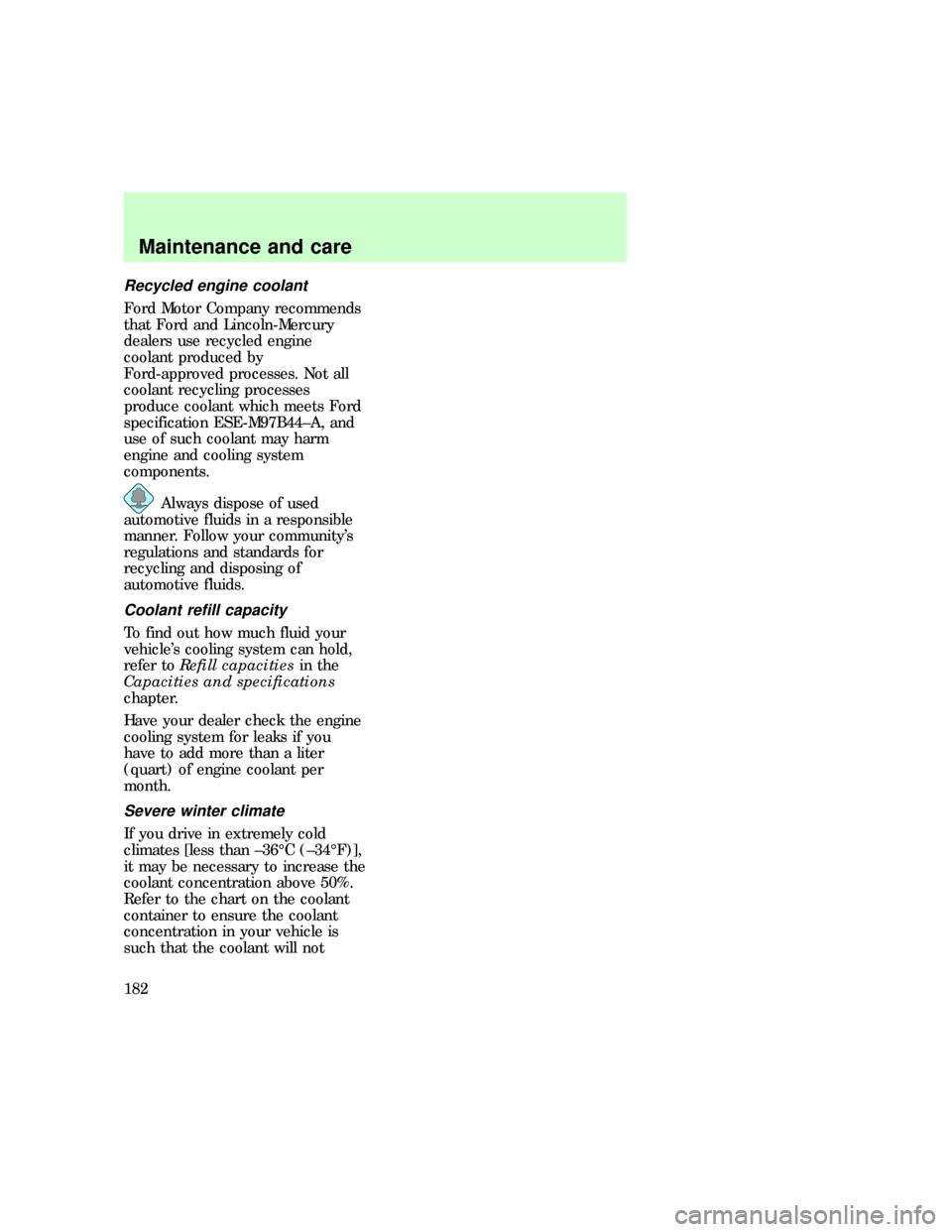
Recycled engine coolant
Ford Motor Company recommends
that Ford and Lincoln-Mercury
dealers use recycled engine
coolant produced by
Ford-approved processes. Not all
coolant recycling processes
produce coolant which meets Ford
specification ESE-M97B44±A, and
use of such coolant may harm
engine and cooling system
components.
Always dispose of used
automotive fluids in a responsible
manner. Follow your community's
regulations and standards for
recycling and disposing of
automotive fluids.
Coolant refill capacity
To find out how much fluid your
vehicle's cooling system can hold,
refer toRefill capacitiesin the
Capacities and specifications
chapter.
Have your dealer check the engine
cooling system for leaks if you
have to add more than a liter
(quart) of engine coolant per
month.
Severe winter climate
If you drive in extremely cold
climates [less than ±36ÉC (±34ÉF)],
it may be necessary to increase the
coolant concentration above 50%.
Refer to the chart on the coolant
container to ensure the coolant
concentration in your vehicle is
such that the coolant will not
com_refill_capacity.01
com_winter_climate.01
Maintenance and care
182
Page 182 of 236
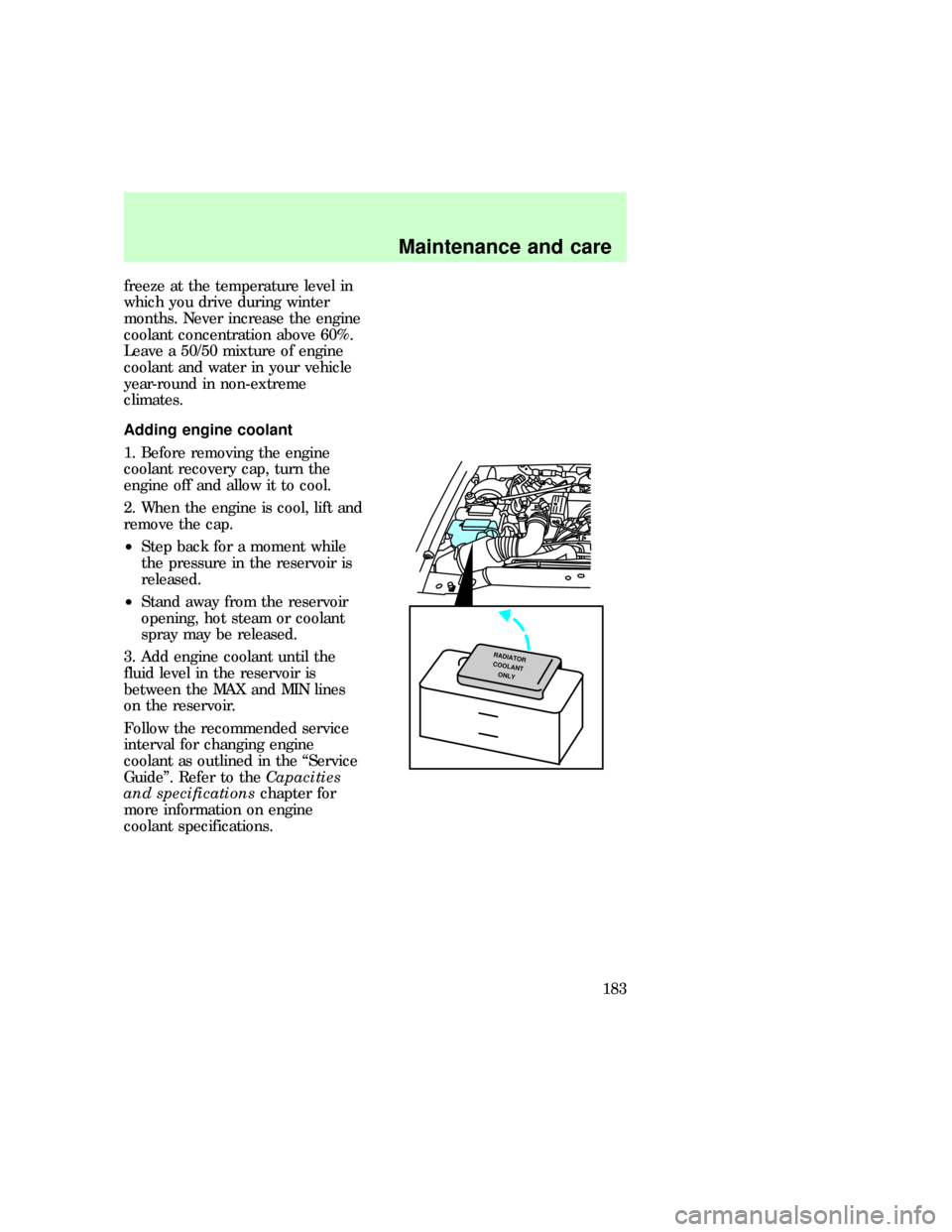
freeze at the temperature level in
which you drive during winter
months. Never increase the engine
coolant concentration above 60%.
Leave a 50/50 mixture of engine
coolant and water in your vehicle
year-round in non-extreme
climates.
Adding engine coolant
1. Before removing the engine
coolant recovery cap, turn the
engine off and allow it to cool.
2. When the engine is cool, lift and
remove the cap.
²Step back for a moment while
the pressure in the reservoir is
released.
²Stand away from the reservoir
opening, hot steam or coolant
spray may be released.
3. Add engine coolant until the
fluid level in the reservoir is
between the MAX and MIN lines
on the reservoir.
Follow the recommended service
interval for changing engine
coolant as outlined in the ªService
Guideº. Refer to theCapacities
and specificationschapter for
more information on engine
coolant specifications.
RADIATOR
COOLANT
ONLY
uno_adding_engine_coolant
com_checking_hoses.01
Maintenance and care
183
Page 183 of 236
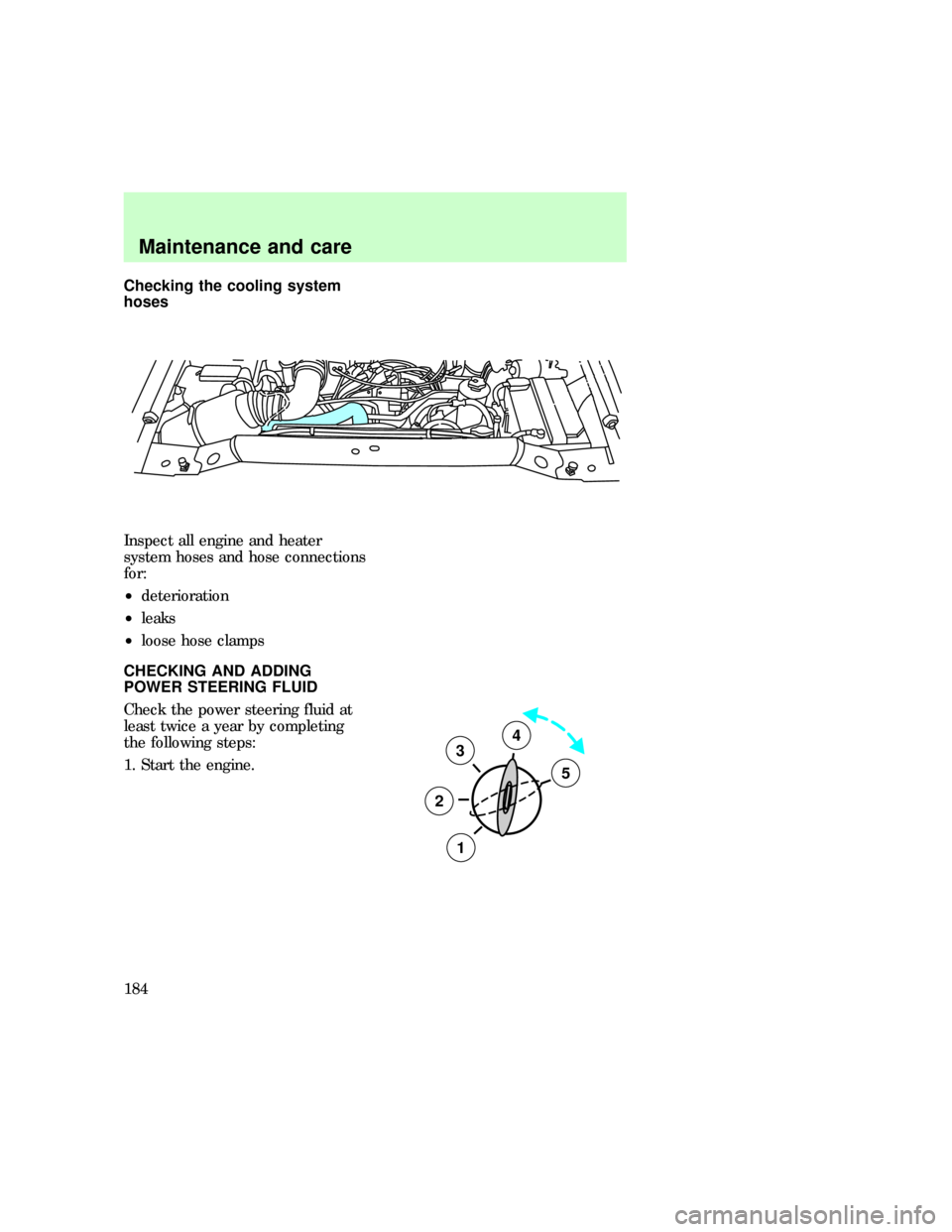
Checking the cooling system
hoses
Inspect all engine and heater
system hoses and hose connections
for:
²deterioration
²leaks
²loose hose clamps
CHECKING AND ADDING
POWER STEERING FLUID
Check the power steering fluid at
least twice a year by completing
the following steps:
1. Start the engine.
3
2
1
5
4
uno_checking_adding_power_st
Maintenance and care
184
Page 184 of 236
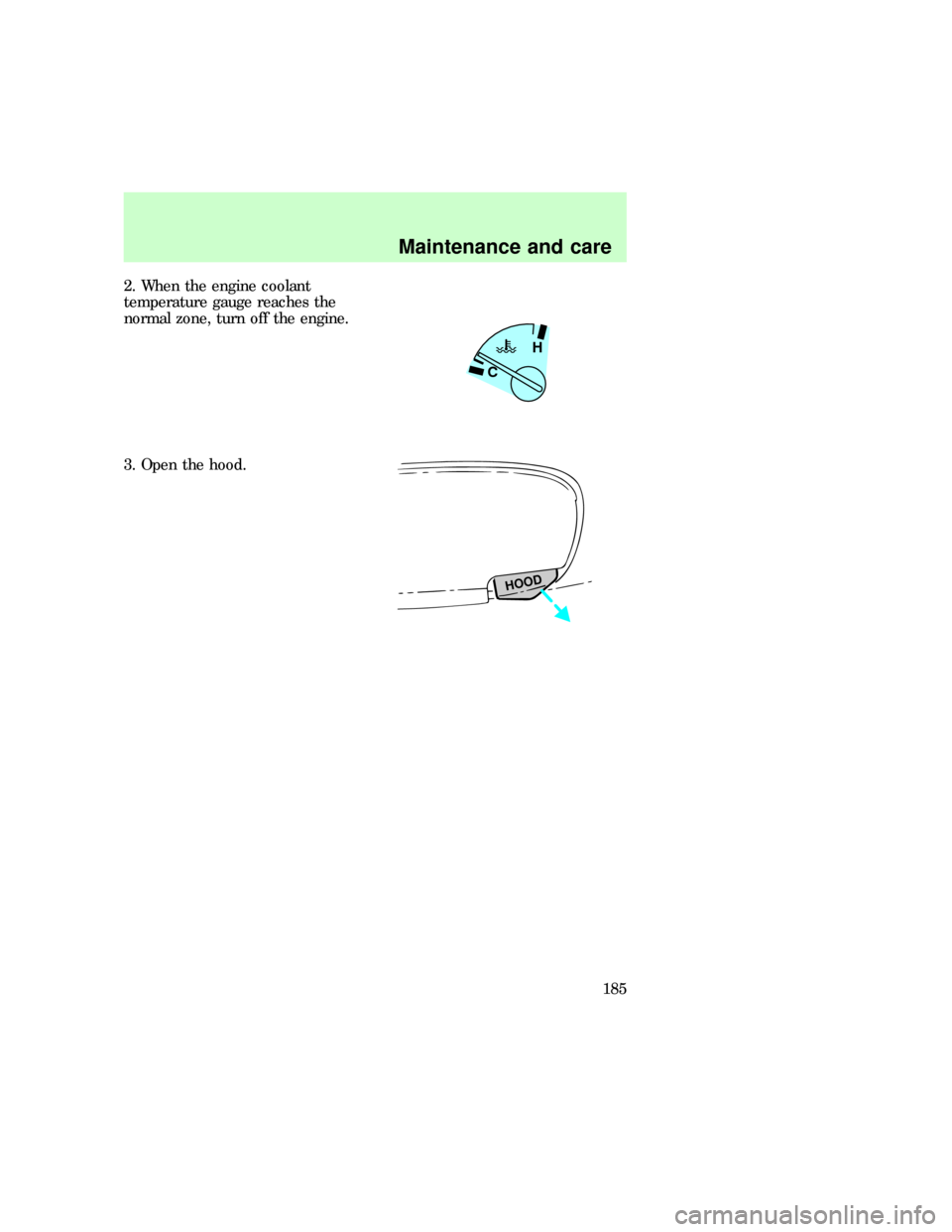
2. When the engine coolant
temperature gauge reaches the
normal zone, turn off the engine.
3. Open the hood.
H
C
HOOD
Maintenance and care
185
Page 185 of 236
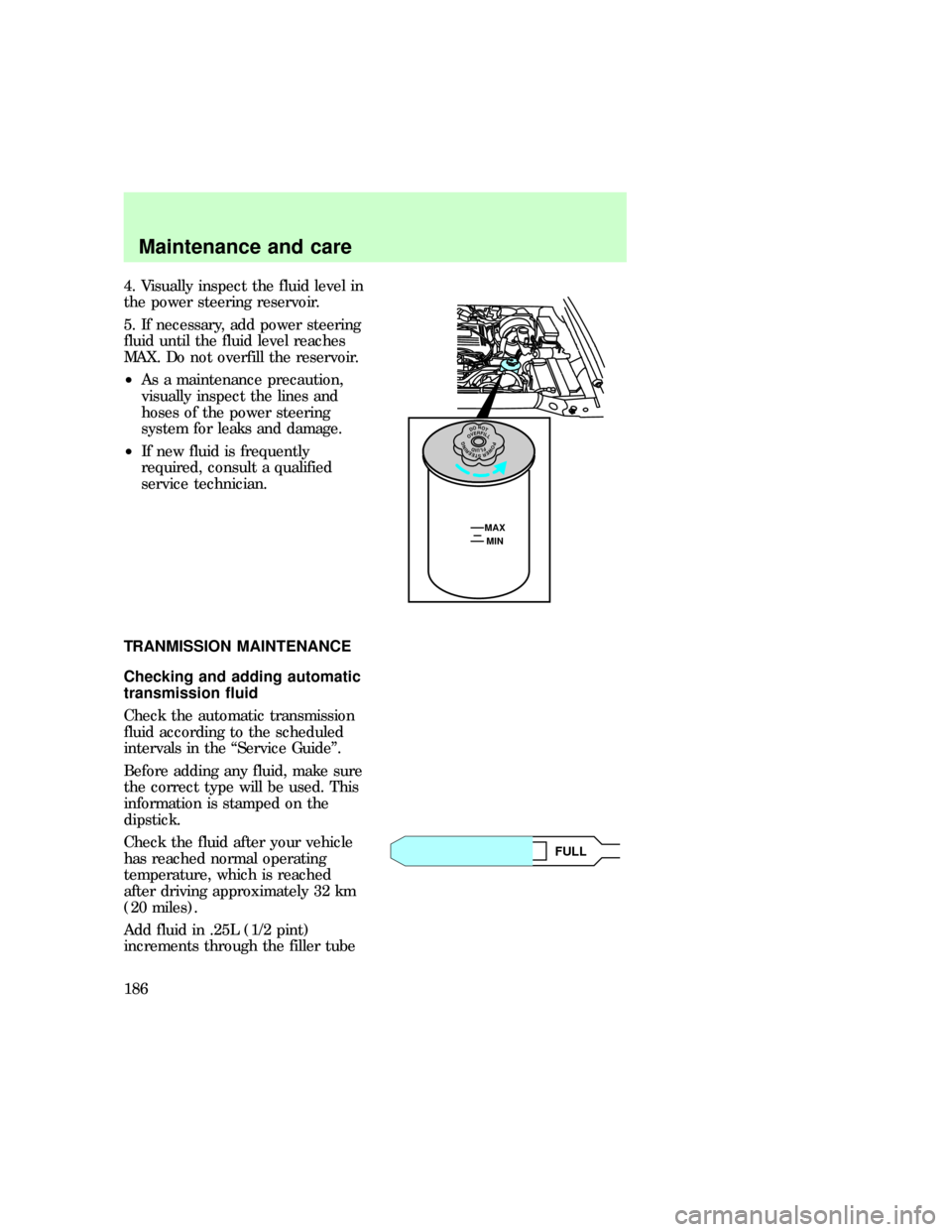
4. Visually inspect the fluid level in
the power steering reservoir.
5. If necessary, add power steering
fluid until the fluid level reaches
MAX. Do not overfill the reservoir.
²As a maintenance precaution,
visually inspect the lines and
hoses of the power steering
system for leaks and damage.
²If new fluid is frequently
required, consult a qualified
service technician.
TRANMISSION MAINTENANCE
Checking and adding automatic
transmission fluid
Check the automatic transmission
fluid according to the scheduled
intervals in the ªService Guideº.
Before adding any fluid, make sure
the correct type will be used. This
information is stamped on the
dipstick.
Check the fluid after your vehicle
has reached normal operating
temperature, which is reached
after driving approximately 32 km
(20 miles).
Add fluid in .25L (1/2 pint)
increments through the filler tube
MAX
MIN
DONOTOVERFILLPOWERSTEERINGFLUID
ADD FULL
uno_trans_fluid_title
com_checking-adding_fluid.02
Maintenance and care
186
Page 186 of 236
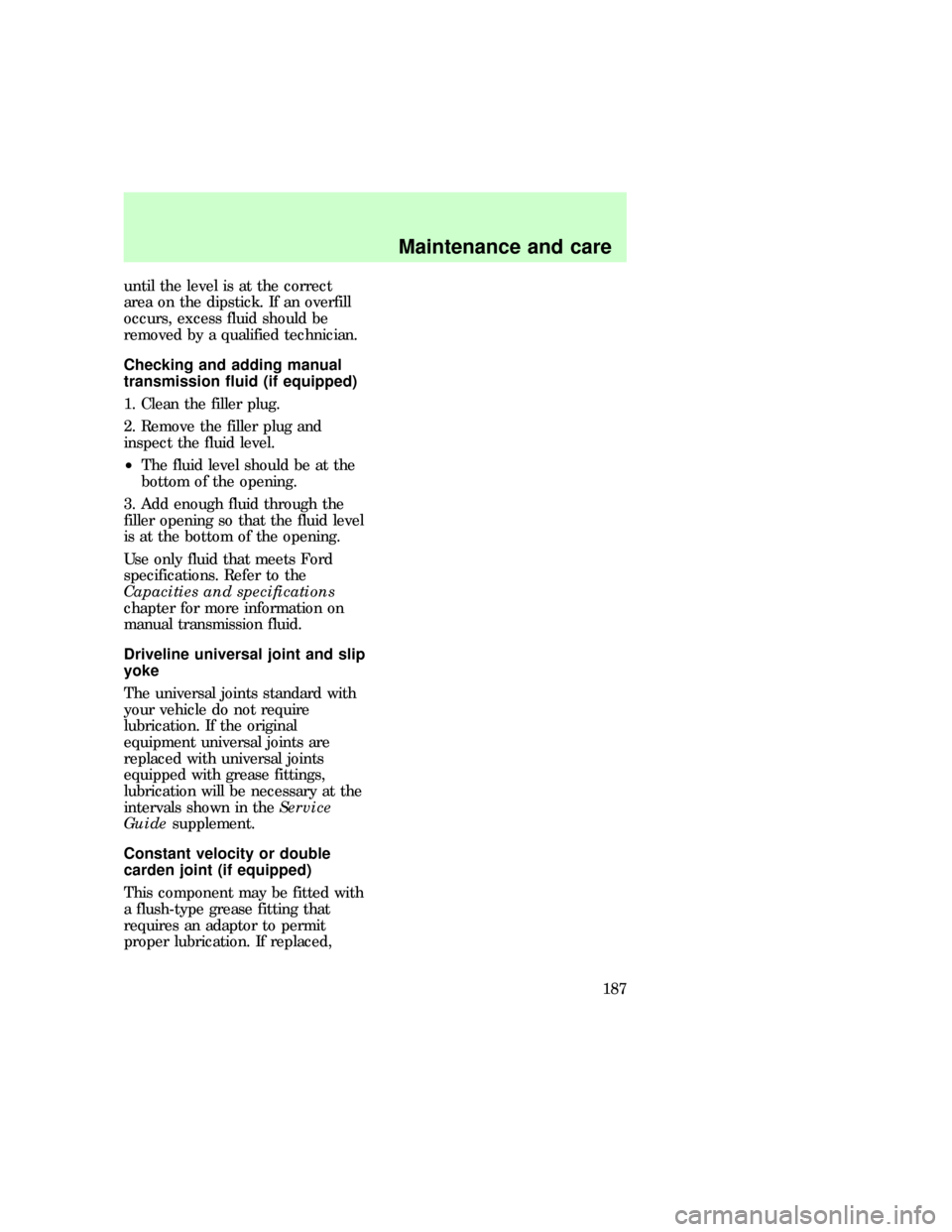
until the level is at the correct
area on the dipstick. If an overfill
occurs, excess fluid should be
removed by a qualified technician.
Checking and adding manual
transmission fluid (if equipped)
1. Clean the filler plug.
2. Remove the filler plug and
inspect the fluid level.
²The fluid level should be at the
bottom of the opening.
3. Add enough fluid through the
filler opening so that the fluid level
is at the bottom of the opening.
Use only fluid that meets Ford
specifications. Refer to the
Capacities and specifications
chapter for more information on
manual transmission fluid.
Driveline universal joint and slip
yoke
The universal joints standard with
your vehicle do not require
lubrication. If the original
equipment universal joints are
replaced with universal joints
equipped with grease fittings,
lubrication will be necessary at the
intervals shown in theService
Guidesupplement.
Constant velocity or double
carden joint (if equipped)
This component may be fitted with
a flush-type grease fitting that
requires an adaptor to permit
proper lubrication. If replaced,
uno_manual_trans_fluid
uno_driveline1
uno_constant_velocity
Maintenance and care
187
Page 187 of 236
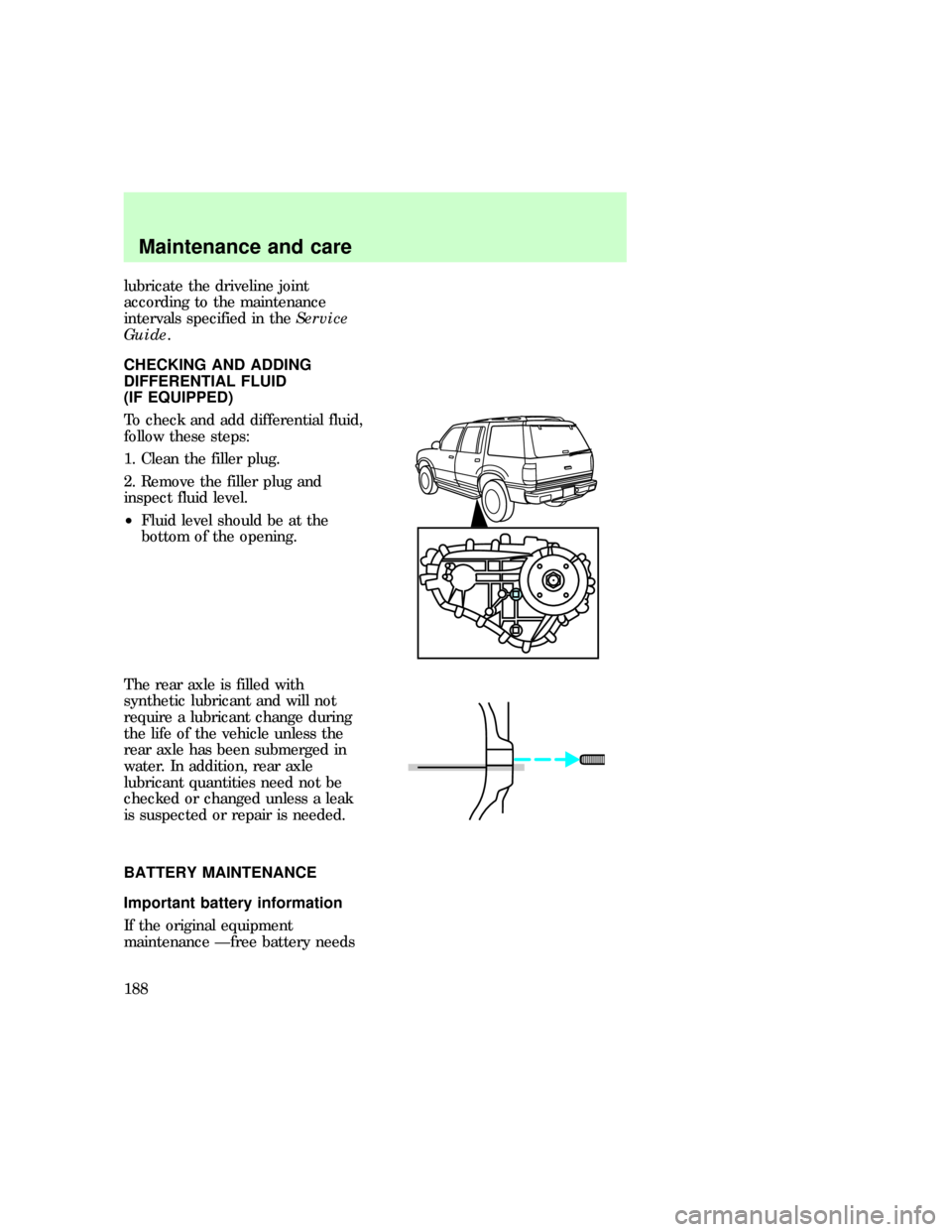
lubricate the driveline joint
according to the maintenance
intervals specified in theService
Guide.
CHECKING AND ADDING
DIFFERENTIAL FLUID
(IF EQUIPPED)
To check and add differential fluid,
follow these steps:
1. Clean the filler plug.
2. Remove the filler plug and
inspect fluid level.
²Fluid level should be at the
bottom of the opening.
The rear axle is filled with
synthetic lubricant and will not
require a lubricant change during
the life of the vehicle unless the
rear axle has been submerged in
water. In addition, rear axle
lubricant quantities need not be
checked or changed unless a leak
is suspected or repair is needed.
BATTERY MAINTENANCE
Important battery information
If the original equipment
maintenance Ðfree battery needs
uno_differentail_fluid
uno_battery_title
uno_info_battery
Maintenance and care
188
Page 188 of 236
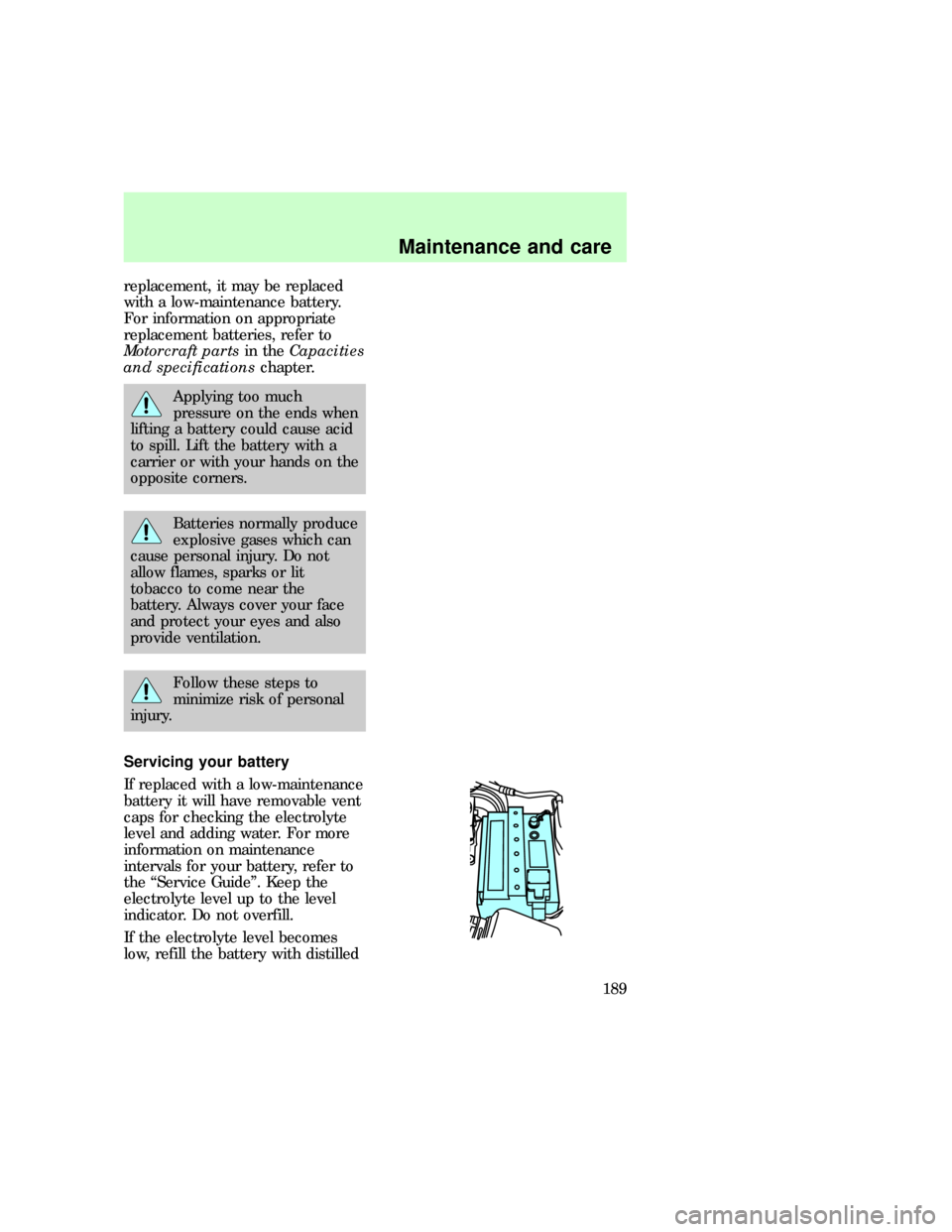
replacement, it may be replaced
with a low-maintenance battery.
For information on appropriate
replacement batteries, refer to
Motorcraft partsin theCapacities
and specificationschapter.
Applying too much
pressure on the ends when
lifting a battery could cause acid
to spill. Lift the battery with a
carrier or with your hands on the
opposite corners.
Batteries normally produce
explosive gases which can
cause personal injury. Do not
allow flames, sparks or lit
tobacco to come near the
battery. Always cover your face
and protect your eyes and also
provide ventilation.
Follow these steps to
minimize risk of personal
injury.
Servicing your battery
If replaced with a low-maintenance
battery it will have removable vent
caps for checking the electrolyte
level and adding water. For more
information on maintenance
intervals for your battery, refer to
the ªService Guideº. Keep the
electrolyte level up to the level
indicator. Do not overfill.
If the electrolyte level becomes
low, refill the battery with distilled
uno_servicing_battery
Maintenance and care
189
Page 189 of 236

water. If necessary, distilled water
may be substituted with tap water
that is not hard and does not have
high mineral or alkali content. If
the battery needs water often,
have the charging system checked
for a possible malfunction.
Relearning the idle function
Because your vehicle's engine is
electronically controlled, some
control conditions are maintained
by power from the battery. When
the battery is disconnected or a
new battery is installed, the
computer must ªrelearnº its idle
conditions before your vehicle can
drive properly. To begin this
process:
Maintenance and care
190
Page 190 of 236
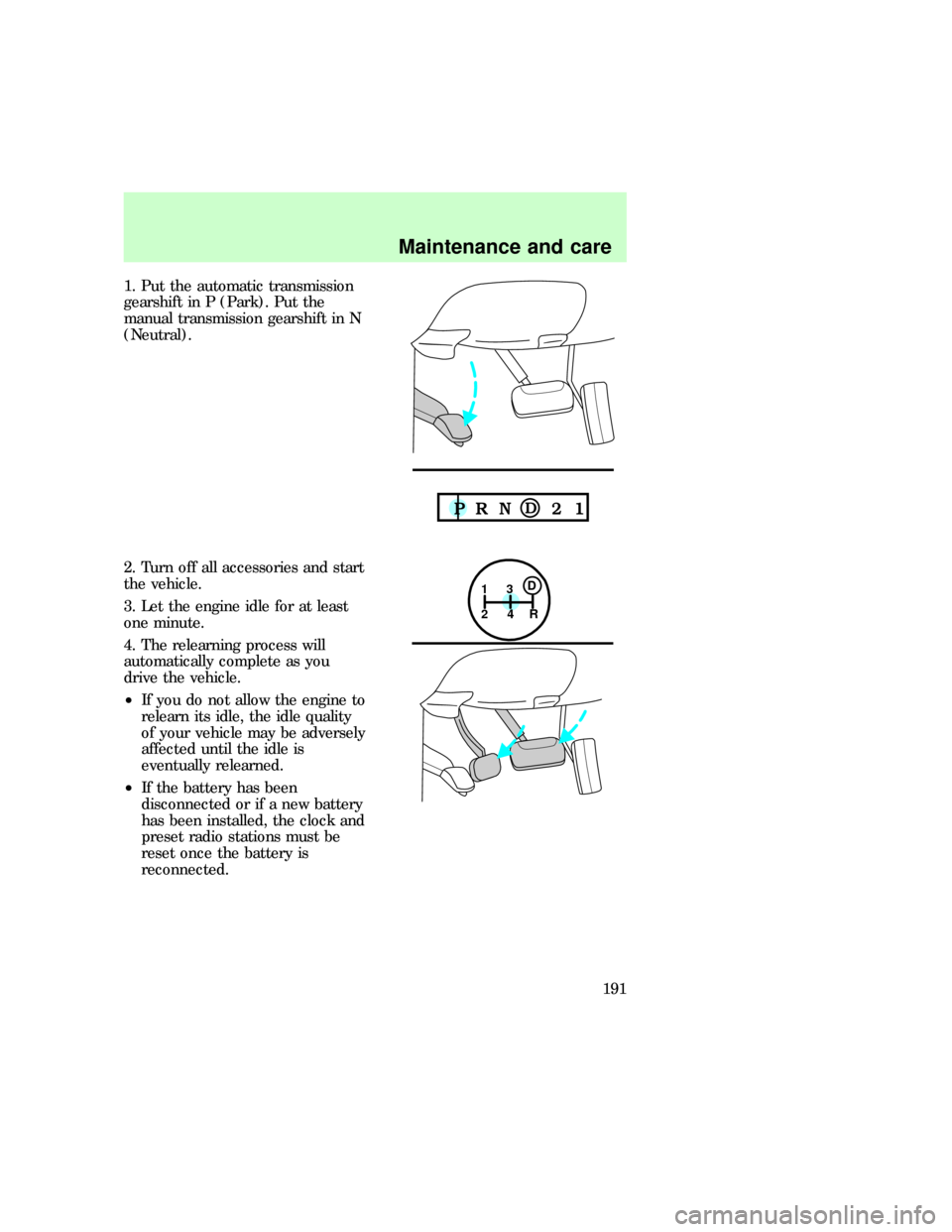
1. Put the automatic transmission
gearshift in P (Park). Put the
manual transmission gearshift in N
(Neutral).
2. Turn off all accessories and start
the vehicle.
3. Let the engine idle for at least
one minute.
4. The relearning process will
automatically complete as you
drive the vehicle.
²If you do not allow the engine to
relearn its idle, the idle quality
of your vehicle may be adversely
affected until the idle is
eventually relearned.
²If the battery has been
disconnected or if a new battery
has been installed, the clock and
preset radio stations must be
reset once the battery is
reconnected.
1
24R3D
Maintenance and care
191